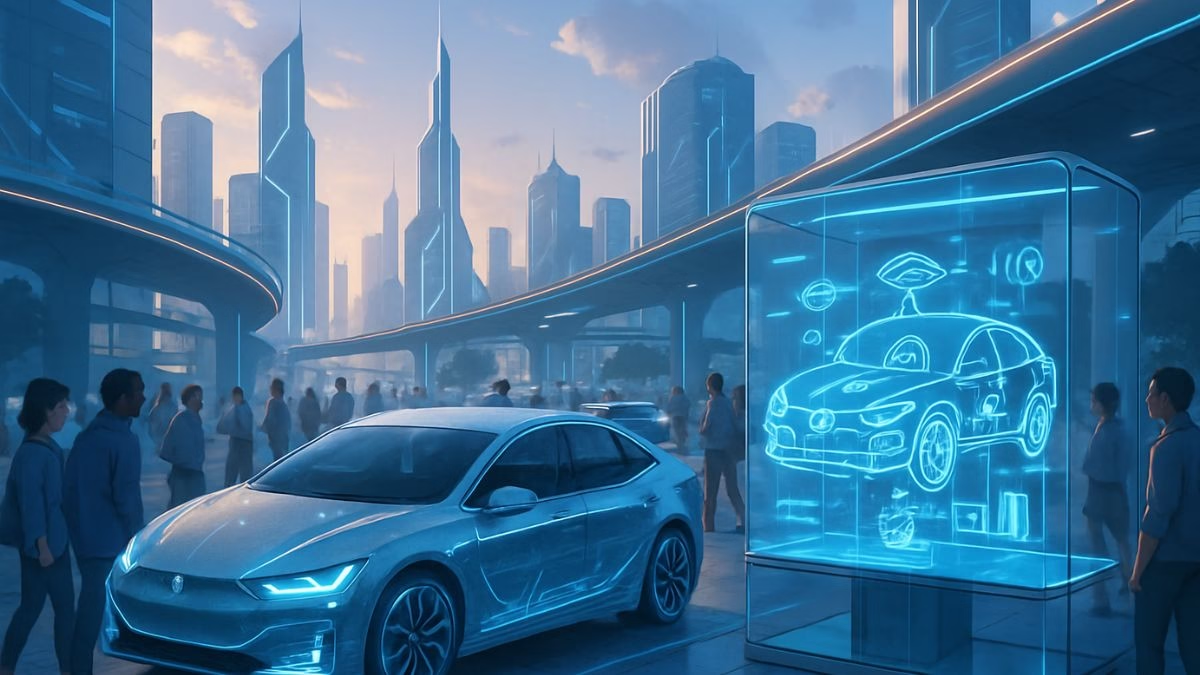Sharpen Your Listening Skills
Welcome to your next listening challenge! This session focuses on a topic at the cutting edge of technology: autonomous vehicles. Listening to academic-style lectures like this is excellent practice for international exams, as it requires you to follow complex explanations and arguments.
To get the most out of this practice, keep these key techniques in mind:
- Anticipate the Structure: The topic is “Autonomous Vehicles: How They Work and Their Future.” Expect the speaker to first explain the technology (the “how they work” part) and then move on to speculate about the consequences (the “future” part). Listen for transition words that signal this shift.
- Differentiate Fact from Speculation: The speaker will present both established facts (how the sensors work) and speculative ideas (predictions about future cities). In your exam, you might be asked to distinguish between what is and what might be. Pay attention to phrases like “It is likely that…,” “could potentially…,” or “The question remains…”
- Listen for Definitions: When a speaker introduces a technical term, like “lidar” or “sensor fusion,” they will often follow it up with a brief definition or explanation. Being able to catch these definitions is a key skill for comprehension.
- Don’t Panic Over Unknown Words: You may hear technical terms you don’t recognize. Don’t let this stop you. Try to understand the word from its context. Often, the main idea is clear even if one or two words are unfamiliar.
Focus, take a deep breath, and let’s delve into the world of self-driving cars.
Listening Audio
Listening Transcript: Please do not read the transcript before you listen and answer the questions.
Good morning. Today, we’re exploring a technology poised to redefine not just transportation, but the very fabric of our cities and societies: autonomous vehicles, more commonly known as self-driving cars. For decades, they were the stuff of science fiction, but today they are a tangible reality, testing on our roads and forcing us to confront profound questions about technology, ethics, and the future of human mobility.
First, let’s demystify how these vehicles operate. An autonomous car’s ability to “see” the world is built upon a sophisticated suite of sensors. The three primary types are cameras, radar, and lidar. Cameras provide high-resolution visual data, allowing the car to recognize traffic lights, read road signs, and identify lane markings. However, they can be hampered by poor weather or low light. This is where radar comes in. Radar uses radio waves to detect objects and measure their speed and distance. It excels in conditions where cameras struggle, like rain, fog, or darkness, but it offers a less detailed picture of the world.
The third, and often most critical, sensor is lidar, which stands for Light Detection and Ranging. Lidar works by emitting millions of laser pulses per second and measuring how long they take to bounce back. This process creates an incredibly precise, real-time 3D map of the car’s surroundings, detailing the exact shape and position of other vehicles, pedestrians, and cyclists. While highly effective, lidar has historically been very expensive, which has been a significant barrier to mass adoption.
Now, having all this raw data from sensors is useless without a brain to process it. This is where a concept called “sensor fusion” comes into play. The car’s central computer continuously takes the input from the cameras, radar, and lidar and fuses them together, creating a single, comprehensive, and redundant model of the environment. This redundancy is paramount for safety. If the camera is blinded by sun glare, the radar and lidar can compensate. This fused data is then interpreted by advanced machine learning algorithms, which make critical driving decisions: when to accelerate, when to brake, when to turn. These algorithms are not programmed with explicit rules for every possible scenario; instead, they are trained on vast datasets of driving data, learning to identify patterns and predict the behavior of other road users.
This brings us to the widely accepted “Levels of Automation,” a scale from 0 to 5. Level 0 is a standard car with no automation. Levels 1 and 2 are what many new cars have today—features like adaptive cruise control or lane-keeping assist, where the driver must remain fully engaged. Level 3 allows the car to handle most driving situations, but the driver must be ready to take back control at a moment’s notice. This is a contentious level, as the handover process can be problematic. Level 4 is high automation, where the car can operate fully on its own within a specific, mapped area or under certain conditions. Finally, Level 5 is full automation—the vehicle can perform all driving tasks, under all conditions, with no human intervention required. This is the ultimate goal, a car with no steering wheel or pedals.
The potential societal benefits of achieving widespread Level 4 and 5 automation are immense. Proponents argue it could dramatically reduce traffic accidents, as over 90% of crashes are caused by human error. It could give us back the countless hours we spend commuting, allowing us to work, relax, or socialize. It could provide newfound mobility for the elderly and people with disabilities. Furthermore, autonomous vehicles could lead to more efficient traffic flow, reducing congestion and pollution. They could also revolutionize logistics and shipping, with convoys of self-driving trucks operating 24/7.
However, the path to this future is fraught with challenges. The technical hurdles remain significant. Autonomous systems still struggle with unpredictable “edge cases”—a construction zone with a confusing layout, a pedestrian behaving erratically, or unusual weather conditions. The cost of the technology, while decreasing, is still a major factor.
Beyond the technical, the ethical and legal frameworks are lagging far behind. The classic ethical dilemma is the “trolley problem” adapted for AVs: in an unavoidable crash, should the car be programmed to prioritize the safety of its occupants or that of pedestrians? Who is liable in the event of an accident: the owner, the manufacturer, the software developer? These are complex questions without easy answers. There are also profound concerns about cybersecurity. The prospect of a fleet of vehicles being hacked is a terrifying one. And finally, there are massive economic and social implications to consider, particularly the displacement of millions of professional drivers, from truckers to taxi drivers.
In conclusion, the journey to a fully autonomous future is not a simple linear progression. It is a complex interplay of technological innovation, regulatory adaptation, ethical debate, and public acceptance. While the vision of a world with safer, more efficient, and more accessible transportation is compelling, the obstacles—technical, ethical, and societal—are equally formidable. The transition will likely be gradual, happening city by city, use-case by use-case, for many decades to come.
Listening Quiz
Keywords & Phrases
Poised to
To be ready to do something or for something to happen.
How we used it: We said the technology is “poised to redefine” transportation. This means it is on the verge of, and in a perfect position to, completely change it.
Demystify
To make a difficult subject clearer and easier to understand.
How we used it: The speaker said, “let’s demystify how these vehicles operate.” This was a signal that they were about to explain a complex topic in simple terms.
Suite of sensors
A set of related components that work together. “Suite” is often used for software or technology.
How we used it: The car’s vision system was described as a “sophisticated suite of sensors.” This indicates it’s not just one sensor, but a collection of different sensors (camera, radar, lidar) working as a system.
Redundancy
The inclusion of extra components that are not strictly necessary to functioning, in case of failure in other components.
How we used it: We explained that sensor fusion creates “redundancy,” which is “paramount for safety.” This means having overlapping systems is a crucial safety feature.
Contentious
Causing or likely to cause an argument; controversial.
How we used it: Level 3 automation was described as “contentious.” This means it is a source of disagreement and debate among experts, primarily because of the handover issue.
Proponents
A person who publicly recommends or supports a particular cause or policy.
How we used it: “Proponents” of AVs are the people who argue in favor of them, pointing to benefits like increased safety and reclaimed commuting time.
Fraught with
Full of (unpleasant things such as problems or dangers).
How we used it: The path to an autonomous future was described as “fraught with challenges.” This phrase powerfully communicates that the journey will be filled with many difficulties.
Edge cases
A problem or situation that occurs only at an extreme (maximum or minimum) operating parameter. In software, it often means a rare, unexpected scenario.
How we used it: We said that AVs struggle with “edge cases.” This refers to those weird, unpredictable events on the road that don’t fit the standard patterns the car was trained on.
Lagging far behind
To be moving or developing much more slowly than someone or something else.
How we used it: The speaker stated that “the ethical and legal frameworks are lagging far behind” the technology. This highlights a common problem where technology develops faster than our rules and laws for governing it.
Formidable
Inspiring fear or respect through being impressively large, powerful, intense, or capable.
How we used it: The obstacles to AV adoption were called “formidable.” This means the challenges are very large and difficult, and they command respect.










0 Comments